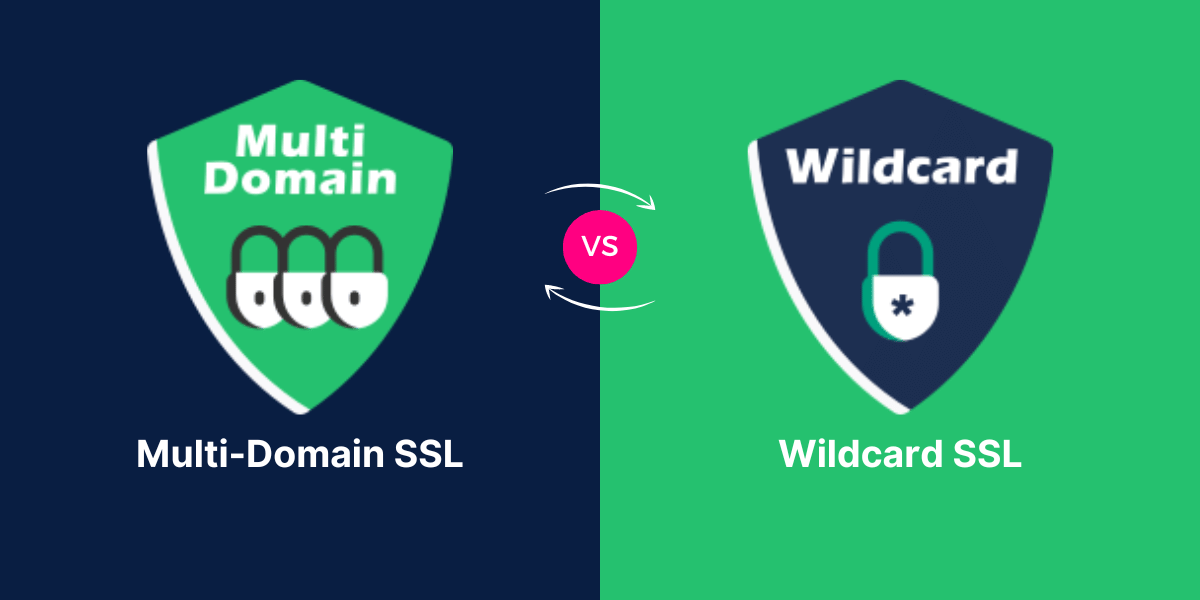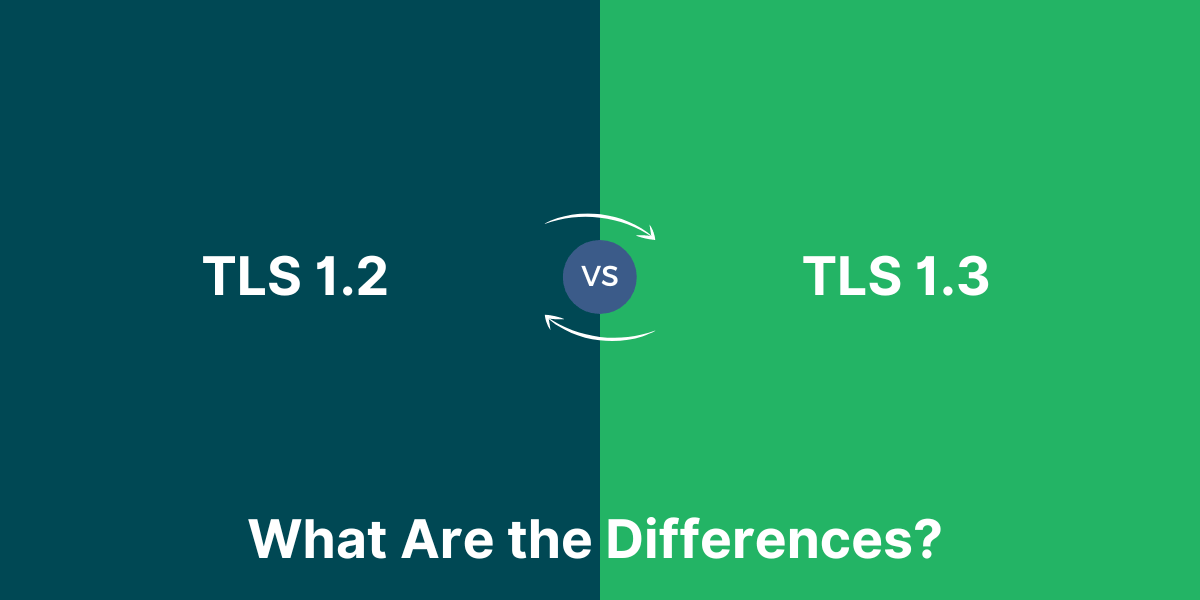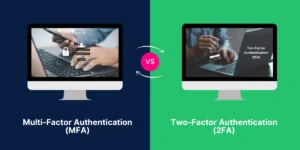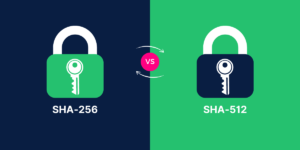Know the Difference Between Multi-Domain SSL and Wildcard SSL Certificate
SSL certificates are essential for securing websites and establishing trust with visitors. Two popular SSL certificate types are multi-domain certificates and wildcard certificates. While they seem similar on the surface, there are some key differences between multi-domain SSL vs wildcard SSL certificates that website owners should understand before deciding which is best for their needs.
Two of the most popular SSL certificate types are multi-domain certificates and wildcard certificates. A multi-domain certificate secures several different domain names under one SSL credential. Wildcard certificates secure unlimited subdomains of a single base domain (e.g., *.example.com).
Understanding the difference between multi-domain vs. wildcard SSL certificates can help website owners choose the optimal type of SSL for their needs and budget. While they both offer security for multiple sites, they work in different ways.
Whether you need to secure multiple top-level domains or various subdomains under one domain, the information below will help determine if a multi-domain or wildcard SSL is right for your websites.
Key Takeaways
- Multi-domain SSL certificates secure multiple domains on the same certificate, while wildcard SSL secures unlimited subdomains of a base domain.
- Wildcard SSL certificates are less expensive than multi-domain certificates for securing a large number of subdomains. However, multi-domain SSLs provide more flexibility.
- Multi-domain SSLs allow mixing different domain names on one certificate, while wildcards only work for subdomains of a base domain.
- Validation requirements are essentially the same for both multi-domain and wildcard SSL certificates.
- Multi-domain SSLs provide the ability to move domains between certificates without being issued. With wildcards, you cannot remove or move the base domain without reissuing.
- Browsers and users treat multi-domain and wildcard SSL certificates identically. They both activate padlock security icons and HTTPS.
Head-to-Head Comparison Between Multi-Domain SSL vs Wildcard SSL
| Feature | Multi-Domain SSL | Wildcard SSL |
|---|---|---|
| Number of Domains Covered | Multiple distinct domains | Unlimited subdomains under a single domain |
| Cost | More expensive per domain | Less expensive per domain |
| Security Level | Same as individual SSL certificates | Same as individual SSL certificates |
| Validation Process | Requires validation for each domain | Requires validation for the root domain only |
| Server Configuration | Requires separate configuration for each domain | Single configuration for all subdomains |
| Flexibility | Allows securing multiple distinct websites or web applications | Best suited for a single website or web application with many subdomains |
| Scalability | Limited to the number of domains covered | Highly scalable for growing websites or web applications |
| Domain Control | Allows you to control and manage individual domains | Only allows control and management of the root domain |
| Renewal Process | Requires renewal for each domain individually | Single renewal for all subdomains |
| Portability | Easier to move to a different hosting provider | More complex to move to a different hosting provider |
| Compliance | Meets industry standards for SSL/TLS certificates | Meets industry standards for SSL/TLS certificates |
| User Experience | Provides a secure and trusted experience for users across multiple domains | Provides a secure and trusted experience for users across all subdomains under the root domain |
A Basic Overview of Multi-Domain SSL Certificates
A multi-domain SSL certificate provides encryption for multiple different fully qualified domain names (FQDNs) on a single certificate.
For example, a multi-domain SSL could protect:
- example.com
- example.net
- example.org
- www.example.com
- mail.example.com
With a multi-domain SSL certificate, each domain name is listed individually within the SSL credential. During the certificate issuing process, the certificate authority validates control and ownership over each separate FQDN.
The validation steps are the same for each domain name on a multi-domain SSL certificate:
Domain Control Validation
To issue a multi-domain SSL, the certificate authority verifies control over each FQDN by requiring the administrator to create a special validation file on the web server or set up DNS TXT/CNAME records. This proves control over the domain’s files or DNS settings.
Organizational Validation
The certificate authority also confirms the organization’s legal identity and standing for each domain name on the certificate by checking official business records and documentation.
Once domain control and organization validation are completed for every domain, the multi-domain SSL certificate is issued. The domains can span separate web properties owned by the same organization.
The benefit of a multi-domain SSL certificate over a regular single-domain SSL certificate is cost savings. Multi-domain SSLs allow securing multiple domains for the price of just one certificate.
A Basic Overview of Wildcard SSL Certificates
Wildcard SSL certificates provide encryption for a base domain plus an unlimited number of subdomains. A wildcard uses an asterisk (*) to represent infinite subdomains.
For example, a wildcard SSL for *.example.com would protect:
- example.com
- www.example.com
- mail.example.com
- images.example.com
- ANY.example.com
The wildcard character replaces the subdomain label, allowing a single certificate to secure an infinite number of subdomains.
With wildcards, the base domain is listed in the certificate, while the subdomains are not explicitly stated. Instead, the unlimited subdomain coverage is inferred by the asterisk wildcard notation.
The validation process for wildcard SSL certificates only requires verifying control of the base domain and organizational vetting for the root FQDN:
Domain Control Validation
The certificate authority validates control of the base domain only (without subdomains) by requiring the administrator to create a DNS TXT record or place a validation file on the server.
Organization Validation
The certificate authority also confirms the legal entity status and identity of the organization for the base domain name only.
Once domain control and organization validation for the root FQDN is completed, any current or future subdomains of that base domain are secured by the wildcard SSL.
The main advantage of a wildcard SSL certificate is convenience. You can secure an unlimited number of subdomains by validating and paying only for the base domain. Adding new subdomains does not require reissuing or revalidating the wildcard SSL.
Key Differences Between Multi-Domain & Wildcard SSL
Now that we’ve explained the basics of multi-domain and wildcard SSL certificates let’s examine some of the key differences that distinguish these two popular certificate types:
Domain Coverage Flexibility
A major difference between multi-domain and wildcard SSL certificates regards flexibility in the domain names they can cover:
- Multi-domain: A multi-domain SSL allows mixing and matching completely different domain names and TLDs (example.com, example.net, etc.) on a single certificate. The domains can span entirely separate properties and don’t need to be related.
- Wildcard: A wildcard SSL only secures subdomains of a single base domain name and TLD (example.com). All subdomains must use the same second-level domain. You cannot mix different TLDs or unrelated domains.
Cost Differences
When it comes to cost, wildcards tend to have the advantage over multi-domain SSLs:
- Multi-domain: Requires full validation for each domain name. More domains mean higher validation effort and cost. Generally, costs increase incrementally with more domains.
- Wildcard: Only requires validating/paying for the base domain to cover all subdomains. Cost does not increase, no matter how many subdomains you have.
Convenience
For convenience, wildcards have a clear benefit once again:
- Multi-domain: Each new domain name needs to be added to the SAN list in the certificate, which may require reissuing the certificate.
- Wildcard: The certificate automatically covers any new subdomain. No updates or changes are required.
The predefined unlimited subdomain coverage of wildcards makes them more convenient than multi-domain SSLs, which may need reissuing when adding new domains.
Moving or Removing Domains
Multi-domain SSL certificates provide better flexibility if you need to move domains between certificates or remove them altogether:
- Multi-domain: You can move individual domains between multi-domain certificates without reissuing them for the other domains. You can also remove domains without affecting others on the certificate.
- Wildcard: The base domain name cannot be removed or moved to a different certificate without reissuing the wildcard credential.
Browser Recognition
Modern web browsers treat multi-domain and wildcard SSL certificates identically:
- Display the padlock security icon in the URL bar
- Enable HTTPS encryption
- Hide security warnings and errors
- Provide the same level of webpage security assurance
Browsers recognize multi-domain SSLs the same way they recognize wildcard SSLs. Users need not learn or care what type of certificate a site uses as long as it’s valid and trusted.
Security Level
Both multi-domain and wildcard SSL certificates offer identical encryption strength:
- 256-bit encryption keys minimum
- Support for latest TLS protocols (1.2/1.3)
- Use strong hashing algorithms like SHA-2 for integrity
- Capable of perfect forward secrecy (PFS) for advanced key encryption
The security of TLS/SSL encryption-protected websites depends more on factors like encryption key size and TLS protocol version, not the specific type of certificate. So wildcards and multi-domain SSLs provide the same high-grade security.
The one security difference regards the validation process:
- Multi-domain—This requires full validation of every domain name on the certificate, ensuring each domain has been thoroughly verified.
- Wildcard: Only the base domain receives complete validation. Subdomains are not checked but are covered by default. There is a slightly higher chance of subdomain misissuance.
Issuing Criteria
The formal issuing criteria for multi-domain and wildcard SSL certificates are nearly identical:
- Must have a valid business, nonprofit, or government organization
- Organizational identity must be verified
- Control of domain(s) must be established
- The certificate must only be used on the organization’s legitimate servers
- Subject to revocation, if used improperly or validation, fails
The only difference regards explicitly verifying each domain name on multi-domain SSLs versus just the base domain on wildcards. Otherwise, issuance policies align closely.
Revocation Implications
If an SSL certificate needs to be revoked, the impact varies between multi-domain and wildcards:
- Multi-domain: Only the affected domain is revoked, while other domains remain active until expiry.
- Wildcard: Revoking the base domain revokes the entire wildcard certificate, including all subdomains secured by it.
Revoking a domain on a multi-domain has limited effect while revoking a wildcard base domain causes complete certificate loss.
When to Use Multi-Domain SSL Certificate
- Securing a relatively small number of different domains and TLDs. Each additional validation drives up costs.
- Covering domains across separate, unrelated web properties.
- Only certain domains require the high assurance of an EV-grade certificate.
- It would help if you moved domains between certificates or accounts flexibly.
- Aggregating domains from mergers, acquisitions, migrations, consolidations, or transfers.
- Revoking a single problematic domain without affecting other domains.
When to Use Wildcard SSL Certificate
- Securing a large number of subdomains is expected to grow over time.
- Coverage is only needed for subdomains of one primary domain.
- Budget is a concern: wildcards cost less than multi-domain at higher subdomain scales.
- Adding new subdomains happens regularly, and you want simplified management.
- You control the primary domain and all current subdomains (can enforce certificate use).
- PKI infrastructure is limited, and there are fewer certificates to manage.
- You do not need to ever separate or isolate the primary domain from subdomains.
For most organizations with multiple established domains, a multi-domain SSL certificate often provides the right blend of flexibility, validation level, and cost savings. Those managing a central primary domain with vast subdomains at scale can benefit most from a true wildcard SSL.
How to Choose the Right Certificate Type between Multi-Domain SSL and Wildcard SSL
- Use multi-domain certificates if you need to mix domains across different TLDs, plan to move domains between certificates, or have a limited number of domains to cover. They provide maximum domain flexibility.
- Choose wildcard certificates if you only need subdomain coverage under one primary domain, expect rapid subdomain growth, or need to manage SSLs at a large scale. Wildcards minimize costs and simplify management with unlimited subdomains.
- Validation requires proving control of every domain name with multi-domain SSL rather than just the base domain with wildcards, but browser recognition is identical.
- Multi-domain certificates make it easier to delete or transfer specific domains if needed. With wildcards, you cannot remove the base domain without reissuing it.
- The security strength offered by both certificate types meets industry best practices for encryption, hash algorithms, key exchange, and TLS protocols.
Final Thoughts
In conclusion, the choice between multi-domain SSL and wildcard SSL certificates depends on the specific needs of your website or web application. Wildcard SSL provides coverage for an unlimited number of subdomains under a single domain, making it a cost-effective option for managing large websites or web applications with many subdomains. Multi-domain SSL, on the other hand, allows you to secure multiple distinct domain names with a single certificate, making it a better choice if you need to manage multiple independent websites or web applications. Ultimately, the decision should be based on the complexity of your web presence, the number of domains or subdomains you need to secure, and your overall security requirements.
Frequently Asked Questions
Can you combine different domain names on a wildcard SSL certificate?
No, wildcard SSL certificates can only cover subdomains of a single base domain name. You must keep multiple top-level domains on a wildcard.
Do multi-domain SSLs cost more than wildcard certificates?
In most cases, yes. Multi-domain SSLs require validating each additional domain name, which increases costs. Wildcards only validate the base domain to cover all subdomains, making them more affordable at a greater scale of subdomains.
Is a wildcard or multi-domain SSL better for SEO?
Neither certificate type provides an inherent SEO advantage. It mainly depends on proper implementation—making sure all domains redirect to their preferred URLs and SERP titles display consistently. Both SSL types allow enabling HTTPS and SSL security icons to provide the same SEO benefit.
Can I use a wildcard and multi-domain SSL certificate on the same domain?
Technically, yes, although it would be redundant. The wildcards would already cover all subdomains, making a multi-domain SSL unnecessary for subdomains of the wildcard’s base domain name. However, you can use a multi-domain on other domains outside the wildcard’s scope.
Do browsers treat a multi-domain SSL differently than a wildcard?
No, all modern browsers recognize multi-domain and wildcard SSL certificates identically. They both activate the padlock icon, HTTPS protocol, and other browser security indicators to assure visitors.
How many domains can I include on a multi-domain SSL certificate?
It depends on the certificate authority, but most multi-domain SSL certificates allow 20-100 different domains to be included on a single certificate. Check your provider’s specific issuing limit.
Can I revoke an individual domain name on a wildcard SSL without losing other subdomains?
No, revoking the base domain of a wildcard SSL revokes the entire certificate, affecting all subdomains secured by the wildcard. With multi-domain SSLs, you can selectively revoke individual domains without impacting the others.
Do mobile browsers treat wildcard and multi-domain SSL differently?
No, popular mobile and tablet browsers like Safari, Chrome, Firefox, etc recognize both certificate types in the same way. They activate HTTPS, encryption, and other security features uniformly for multi-domain SSLs and wildcards.
Does a wildcard or multi-domain SSL have stronger validation?
Multi-domain SSLs generally involve more rigorous validation since every distinct domain must pass domain ownership checks. With wildcards, only the base domain is fully validated. However, both are strong standards.
Can I use a multi-domain SSL to secure domain aliases and internal hostnames?
Yes, multi-domain SSL certificates allow securing related domains, aliases, masked domains, internal hostnames, and other variations of a primary domain alongside external domains. This can help simplify management.

Priya Mervana
 Verified Web Security Experts
Verified Web Security Experts
Priya Mervana is working at SSLInsights.com as a web security expert with over 10 years of experience writing about encryption, SSL certificates, and online privacy. She aims to make complex security topics easily understandable for everyday internet users.



